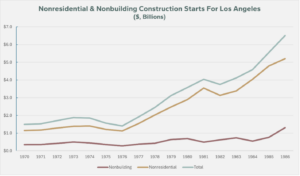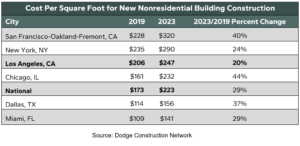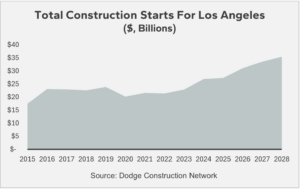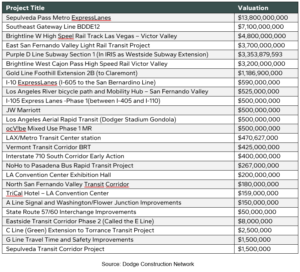by Ralph Flores, Economist at Dodge Construction Network
The Olympic Games are a vibrant celebration that goes beyond sports, serving as a dynamic showcase of human capability, fostering global unity, and embodying the relentless pursuit of greatness. Every four years, the world gathers for an extraordinary showcase of athletic skill, cultural exchange, and shared experiences. Athletes from every corner of the globe push their limits, demonstrating feats that inspire people everywhere. This event highlights cultural exchange, with host cities and participating countries proudly presenting their unique traditions. Captivating millions of spectators, both in person and through broadcasts, the Olympics create lasting memories and emotional moments, underscoring the power of sport to unite and inspire humanity on a global stage.
As we near the closing of the 2024 Paris Olympics, Los Angeles is gearing up to host the 2028 Summer Olympics by drawing on its previous experience from 1984 to plan a “no build” Olympics. When referring to a “no build” Olympics, it doesn’t mean that no new construction is taking place. Rather, it means that the city is largely utilizing existing venues and infrastructure rather than constructing new stadiums and sports facilities specifically for the Games. This approach is designed to minimize costs and avoid the pitfalls of constructing new, potentially underutilized venues once the flames end. However, significant investments are still being made to upgrade transportation, revamp existing facilities, and enhance the city’s infrastructure. These upgrades are poised to leave a lasting legacy, benefiting Angelenos long after the Olympic flame has been extinguished.
Learning from Past Olympics
Comparing LA’s “no build” approach to past Olympics that involved extensive new venue construction, the benefits are clear. Cities that invested heavily in new sports facilities often found themselves with underutilized facilities post-Games. In contrast, Los Angeles’ focus on upgrading existing infrastructure ensures that the investments will continue to serve the city’s needs well beyond 2028. A notable example of an Olympic project that faced significant challenges and failures, leaving a lasting financial and environmental burden on its host city is the 1976 Montreal Olympics. The construction of the iconic Montreal Olympic Stadium was plagued by delays, mismanagement, and massive cost overruns. In US dollar terms, what was initially estimated as a $112 million project in 1970 had ballooned to $970 million by the time the unfinished stadium opened in 1976. After 30 years of accruing interest, repairs, and accounting for inflation, the total expenditure skyrocketed to over $1.47 billion when the costs were finally paid off in 2006 – a staggering amount at the time, making it the second most expensive stadium ever built.
Similarly, the 2016 Rio Olympics left a troubling legacy. Despite the initial excitement and promises, the event was marred by environmental damage, displacement of local communities, and the construction of venues that have seen limited use since the Games. The once-celebrated Olympic Park and other facilities now stand largely abandoned, raising concerns about the long-term benefits and sustainability of such massive investments.
More recently the 2020 Tokyo Olympics, held in 2021 due to the COVID-19 pandemic, also faced immense challenges. Strict health protocols were implemented, and events took place in largely empty venues without spectators, severely impacting Japan’s hopes of recouping investments through tourism and ticket sales. The postponement alone added an estimated $1.9 billion to the already high $13 billion price tag. The Tokyo Olympics highlighted the vulnerability of mega-events to unpredictable global crises like pandemics.
These cautionary tales highlight the importance of careful planning, responsible management, and a commitment to creating a lasting, positive impact for host cities and their residents. Failure to do so can result in financial burdens, environmental degradation, and a squandering of valuable resources that could have been better allocated towards more sustainable and beneficial projects.
Los Angeles plans to emulate the successful approaches of the 2012 London Olympics and the 1992 Barcelona Games in hosting the 2028 event. Like London, which extensively utilized existing facilities and temporary venues to minimize waste, Los Angeles aims to leverage its existing infrastructure and limit new construction. Barcelona, on the other hand, serves as a prime example of how hosting the Olympics can positively transform a city. The 1992 Games prompted significant urban redevelopment, including the construction of new sports facilities, a new beach, and improved transportation infrastructure. These projects revitalized Barcelona, boosted tourism, and left a lasting positive legacy.

Interestingly, Los Angeles is also drawing inspiration from its own history as the host of the 1984 and 1932 Olympics. Notably, the iconic Coliseum, built in 1923, is about to see its third Olympics, a testament to the city’s legacy and enduring infrastructure. During those Games, the city kept costs down by building only two new venues specifically for the Olympics: the Olympic Swim Stadium at the University of Southern California (USC) for diving and swimming events, and the Olympic Velodrome at California State University, Dominguez Hills (CSUDH) for track cycling competitions. In Chart #1 it’s worth nothing a slight uptick in construction activity leading up to the 1984 Olympics. However, this growth cannot be solely attributed to the Olympics, but was part of a broader cyclical growth pattern seen in many metro areas across the country during that time. The sustained growth, however, could suggest that the 1984 Los Angeles Olympics may have acted as a catalyst, accelerating development and investment in the region, but the other underlying economic fundamentals and a favorable business climate were more than likely the primary drivers of the prolonged construction and economic upswing.
Another significant factor influencing this decision is the high cost per square foot for the construction of new nonresidential buildings in Los Angeles. In recent years, LA’s cost per square foot for nonresidential buildings has increased by 20%, reaching an average of $247. Los Angeles has stringent seismic codes, which significantly drive-up construction costs compared to other metropolitan areas. The “no build” plan, therefore, helps keep costs down by utilizing existing structures and minimizing new construction, which would otherwise be prohibitively expensive due to these stringent regulations.

Investment and Construction Projects
Los Angeles is seeing a substantial influx of investment in infrastructure improvements and other projects. Although these projects were not created specifically for the Olympics, the Olympics’ timeline has definitely given them an extra push to be completed before the Games begin. While no new permanent venues are being built, these projects are critical for supporting the influx of visitors and ensuring smooth operations during the event. At Dodge Construction Network, we leverage the power of Dodge Construction Central 2.0, the industry’s most comprehensive construction data solution, to track and analyze these key projects. This tool is invaluable for contractors, manufacturers, architects, and construction companies, providing access to timely intelligence and helping them connect with key partners and opportunities. Key projects and their costs include:
- Sepulveda Pass Metro ExpressLanes ($13.8 billion): This transformative project aims to reduce congestion and improve connectivity along one of LA’s busiest corridors, facilitating efficient movement of people and goods during the Olympics.
- The Southeast Gateway Line ($7.1 billion): Formerly known as the West Santa Ana Branch Transit Corridor, this new light rail line will improve connectivity and accessibility in the region, benefiting both residents and Olympic attendees.
- Brightline West High Speed Rail to Las Vegas ($4.8 billion): This high-speed rail link will significantly cut travel time between LA and Las Vegas, offering a convenient and eco-friendly alternative to driving or flying for Olympic attendees and tourists.
- Purple D Line Subway Section 1 ($3.3 billion): Part of the Westside Subway Extension, this project will enhance the city’s public transportation network, providing a vital link for efficient movement during the Olympic Games.
- LA Aerial Rapid Transit/Dodger Stadium Gondola ($500 million): By providing a new, efficient transit option to the iconic Dodger Stadium, this gondola system will enhance accessibility for both locals and visitors attending Olympic events at the venue.
- LAX/Metro Transit Center Station ($470 million): A project focused on a more streamline transit connection for the Los Angeles International Airport, facilitating smoother and more efficient travel for Olympic attendees and other travelers.
- Los Angeles River bicycle path ($525 million): This extensive bicycle path along the LA River will offer a sustainable and active transportation option, potentially alleviating traffic congestion during the Olympics.
- LA Convention Center Exhibition Hall ($200 million): Expanding the convention center’s exhibition space will provide additional capacity to host Olympic-related events and accommodate the influx of visitors during the Games.
Impacts
The economic impacts of these construction projects are profound. The investment is expected to generate thousands of jobs, significantly boosting the local economy. The Los Angeles County Metropolitan Transportation Authority is receiving $900 million from the federal government to enhance its infrastructure ahead of the 2028 Olympics. This funding, sourced from the bipartisan infrastructure law, aims to improve transportation projects and safety, ensuring readiness for the Olympics and leaving a lasting impact on the city’s infrastructure. The Olympics Games are projected to significantly benefit the regional economy. A study by the University of California, Riverside, estimated that the Olympics could have an $11 billion economic impact, including $7 billion in direct spending. This influx is expected to create up to 79,000 new full-time jobs and generate $167 million in tax revenue. This study was initially conducted when Los Angeles was a candidate for the 2024 Olympics. Now, with the Games scheduled for 2028, the projections are still highly relevant and highlight the potential economic benefits. The organizing committee for the 2028 Summer Olympic and Paralympic Games, LA28, also anticipates over $4.4 billion revenue from corporate sponsorships and ticket sales. Chart #2 displays the historical trend for total construction starts in the Los Angeles metropolitan area, including Dodge’s forecasted data through 2028. This detailed outlook offers valuable insights into the expected levels of construction activity leading up to and during the city’s hosting of the 2028 Olympic Games.

As a city notorious for its traffic problems, Los Angeles will benefit from enhancements like the Sepulveda Pass Metro Express Lanes and the Purple D Line Subway Section 1. These projects are designed to alleviate congestion and improve connectivity, making daily commutes more efficient. The new and upgraded transit systems will provide both short-term support for the influx of Olympic visitors and long-lasting benefits for residents. Beyond accommodating the Games, these projects aim to facilitate smoother, faster, and more sustainable transportation options that enhance daily commutes, reduce traffic congestion, and improve air quality, creating a lasting positive impact on the city’s infrastructure and quality of life. The economic ripple effects include increased property values, stimulated business growth, and enhanced tourism appeal.
Beyond transportation, several sectors are set to benefit significantly from investments. Some large projects include the $500 million JW Marriott hotel expansion at LA Live, the $500 million ocV!be mixed use project, and the estimated $159 million TriCal Hotel at the LA Convention Center. These developments will greatly enhance the city’s hospitality and tourism infrastructure, creating new jobs and providing a significant boost to local businesses. The influx of visitors will increase the demand for accommodations and services, pushing existing hotels to their limits and necessitating the addition of fresh, new options. These projects will also generate substantial economic activity, contributing to the overall growth and development of Los Angeles.
Risks and Conclusion
By enhancing existing infrastructure rather than building new, potentially superfluous venues, LA is likely to avoid the financial burdens and underutilization issues faced by previous host cities, particularly given its experience and established infrastructure from hosting the Games previously. The focus on transportation and accessibility projects ensures that the benefits will be widely felt by the local population, contributing to long-term economic growth and improved quality of life.
The Los Angeles Metro has a busy timeline, with numerous infrastructure projects slated for completion well before the 2028 Olympic Games. LA hopes that this strategic scheduling will allow Metro to use other high-profile events like the 2026 FIFA World Cup and the 2027 Super Bowl as dress rehearsals. By managing transportation logistics for these major sporting spectacles, Metro can fine-tune its operations and readiness to play a pivotal role in ensuring seamless mobility during the 2028 Olympics and Paralympics.
However, potential pitfalls include the risk of cost overruns and delays, common in large-scale infrastructure projects. Additionally, there must be careful planning to ensure that these projects are fully integrated into the city’s broader transportation network and urban planning strategies to maximize their utility. The construction labor shortages felt across the county could slow down project timelines. Material prices are another concern, with global supply chain disruptions potentially driving up costs and causing additional delays. Careful management and contingency planning will be crucial to navigate these issues and ensure timely completion.
In conclusion, the construction projects planned in preparation for the 2028 Los Angeles Olympics embody a forward-thinking strategy that emphasizes sustainability and long-term benefits. By leveraging existing infrastructure and making strategic investments in key areas, LA is setting an example for how cities can host global events in a way that enhances their legacy and benefits residents for decades to come, building on the successful approaches of both the 2012 London Olympics and its own 1984 plan.
Dodge Construction Network remains committed to providing comprehensive data and analysis on construction trends and impacts. We look forward to monitoring the progress of these projects and their contributions to the vibrant future of Los Angeles.
Appendix
Acknowledgments
The detailed list of projects provided in this document was the result of significant efforts by key members of our planning team. We extend our gratitude to Mary-Jo Checco, Director of Data Acquisition, Linda St. Peter, Planning Team Manager, and Gabe Hendrick, Planning Team Manager, for their invaluable contributions in collecting and compiling the project data.
Here is a more comprehensive list of projects with an aim to be finished before the 2028 Los Angeles Olympics:

**The list of projects is not intended to be comprehensive as projects can be added and removed over time.
***The data and projects referenced in this write-up were updated through June 2024.
Bibliography
Legislative Analyst’s Office. “Considering an Official Bid for the 2024 Olympics.” Last modified February 21, 2017. https://lao.ca.gov/reports/2017/3553/2024-Olympics-022117.pdf
Legislative Analyst’s Office. “Update on Los Angeles’ Bid for the 2024 Olympics.” Last modified March 23, 2017. https://www.lao.ca.gov/Publications/Report/3622
Los Angeles 2028 Organizing Committee. Accessed June 12, 2024. https://la28.org/
Center for Economic Forecasting and Development, and Beacon Economics. “Analysis of Economic, Fiscal, & Social Impacts of the 2024 Olympic and Paralympic Games in Los Angeles.” Accessed June 12, 2024. https://www.insidethegames.biz/media/file/54307/UCRiversideEconomicAnalysis%20%282%29.pdf
